Assessment of Land Use Pattern and Landscape Ecological Risk in the Chengdu-Chongqing Economic Circle, Southwestern China
Abstract
:1. Introduction
2. Materials and Methods
2.1. Study Area
2.2. Data Sources
2.3. Methods
2.3.1. Land Use Dynamic Degree (LUD)
2.3.2. Landscape Ecological Risk Index
2.3.3. Risk Subdivision
3. Results
3.1. Evolution of Land Use Landscape Pattern
3.2. Ecological Risk Analysis of Landscape Land Use Types
3.2.1. Risk Index Analysis of Ecological Risk Communities
3.2.2. Spatiotemporal Analysis of Landscape Ecological Risk
3.2.3. Ecological Risk Analysis of the Chengdu-Chongqing Economic Circle
4. Discussion
5. Conclusions
Author Contributions
Funding
Institutional Review Board Statement
Informed Consent Statement
Data Availability Statement
Acknowledgments
Conflicts of Interest
References
- Wang, K.; Lin, C.; Wu, C. Trends and planning choices after China’s urbanization rate reaching above 60%. City Plan. Rev. 2020, 44, 9–17. [Google Scholar]
- Wang, Z. Under the construction of talent team “first hand chess” to build Chengdu-Chongqing area shuangcheng economic circle important growth pole. Contemp. Party 2020, 19, 41–42. [Google Scholar]
- Huang, H.; Zhang, Q. Create an important growth pole and a new driving force for high-quality development across the country. Pioneer 2020, 11, 37–39. [Google Scholar]
- Wang, F.C.; Wang, D.C.; Zhang, L.H.; Liu, J.; Hu, B.; Sun, Z.; Chen, J. Spatiotemporal analysis of the dynamic changes in land use ecological risks in the urban agglomeration of Beijing-Tianjin-Hebei vegion. Acta Ecol. Sin. 2018, 38, 4307–4316. [Google Scholar]
- Westman, W.E. Ecology, Impact Assessment, and Environmental Planning; John and Wiley and Sons: Chichester, UK, 1984; pp. 212–223. [Google Scholar]
- Hunsaker, C.T.; Graham, R.L.; Suter, G.W.; O’Neill, R.V.; Barnthouse, L.W.; Gardner, R.H. Assessing ecological risk on a regional scale. Environ. Manag. 1990, 14, 325–332. [Google Scholar] [CrossRef]
- Chen, X.; Xie, G.; Zhang, J. Landscape ecological risk assessment of land use changes in the coastal area of Haikou City in the past 30 years. Acta Ecol. Sin. 2021, 41, 975–986. [Google Scholar]
- Peng, J.; Dang, W.X.; Liu, Y.X.; Zong, M.L.; Hu, X.X. Review on landscape ecological risk assessment. Sci. Geogr. Sin. 2015, 70, 664–677. [Google Scholar]
- Liu, D.; Yang, Y.; Zou, C. Thoughts on the Construction of Ecological Barrier in the Upper Reaches of the Yangtze River Under the Great Protection Strategy of the Yangtze River Economic Belt. Environ. Prot. 2019, 47, 22–25. [Google Scholar]
- Ke, X.; Gui, S.; Huang, H.; Zhang, H.; Wang, C.; Guo, W. Ecological risk assessment and source identification for heavy metals in surface sediment from the Liaohe River protected area, China. Chemosphere 2017, 175, 473–481. [Google Scholar] [CrossRef]
- Yang, Q.; Li, Z.; Lu, X.; Duan, Q.; Huang, L.; Bi, J. A review of soil heavy metal pollution from industrial and agricultural regions in China: Pollution and risk assessment. Sci. Total Environ. 2018, 642, 690–700. [Google Scholar] [CrossRef]
- Han, W.; Gao, G.; Geng, J.; Li, Y.; Wang, Y. Ecological and health risks assessment and spatial distribution of residual heavy metals in the soil of an e-waste circular economy park in Tianjin, China. Chemosphere 2018, 197, 325–335. [Google Scholar] [CrossRef] [PubMed]
- Du, Y.Y.; Peng, J.; Zhao, S.Q.; Hu, Z.C.; Wang, Y.L. Ecological risk assessment of landslide disasters in mountainous areas of Southwest China:A case study in Dali Bai Autonomous Prefecture. Sci. Geogr. Sin. 2016, 71, 1544–1561. [Google Scholar]
- Wang, C.; Ba, R.; Zhou, H.; Liu, Y.; Deng, G. Risk Evaluation of Debris Flows in Urban Area of Shimian County of Sichuan Province. Acta Ecol. Sin. 2014, 21, 219–223+228. [Google Scholar]
- Li, Y.; Tan, W.; Li, J.; Li, J.; Jiang, J. Environmental risk assessment method of coal mine rust water to drinking water sources and case study. J. Environ. Eng. Technol. 2021, 11, 823–828. [Google Scholar]
- Bo, F. Research on Ecological Risk Assessment in Neijiang Zigong Luzhou Section of “Chuan-Nan” High-Speed Railway. Master’s Thesis, Southwest Jiaotong University, Chengdu, China, 2017. [Google Scholar]
- Lu, Y.L.; Xu, L.F.; Ma, Z.W.; Yan, L.; Xu, X.G. Ecological risk assessment of five provinces around the Bohai Sea. Chin. J. Ecol. 2012, 31, 227–234. [Google Scholar]
- Wang, H.; Rao, E.; Xiao, Y.; Yan, Y.; Lu, H.; Zhu, J. Ecological risk assessment in Southwest China based on multiple risk sources. Acta Ecol. Sin. 2018, 38, 8992–9000. [Google Scholar]
- Du, J.; Zhao, S.; Qiu, S.; Guo, L. Land Use Change and Landscape Ecological Risk Assessment in Loess Hilly Region of Western Henan Province from 2000 to 2015. Acta Ecol. Sin. 2021, 28, 279–284+281. [Google Scholar]
- Hou, R.; Li, H.; Gao, Y. Ecological Risk Assessment of Land Use in Jiangxia District of Wuhan Based on Landscape Pattern. Acta Ecol. Sin. 2021, 28, 323–330+403. [Google Scholar]
- Xu, Z.Y.; Luo, Q.H.; Xu, Z.L. Consistency of Land Cover Data Derived from Remote Sensing in Xinjiang. J. Geogr. Inf. Sci. 2019, 21, 427–436. [Google Scholar]
- Liu, D.; Chen, H.; Zhang, M.; Shang, S.; Liang, X. Analysis of Spatial-temporal Distribution of Landscape Ecological Risk in Ecologically Vulnerable Areas and Its Terrain Gradient—A Case Study of Mizhi County of Shaanxi Province. Res. Soil Water Conserv. 2019, 26, 239–244+251. [Google Scholar]
- Yu, L.; Zhang, F.; Zang, K.; He, L.; Wan, F.; Liu, H.; Zhang, X.; Shi, Z. Potential Ecological Risk Assessment of Heavy Metals in Cultivated Land Based on Soil Geochemical Zoning: Yishui County, North China Case Study. Water 2021, 13, 3322. [Google Scholar] [CrossRef]
- Zhang, S.; Zhong, Q.; Cheng, D.; Xu, C.; Chang, Y.; Lin, Y.; Li, B. Coupling Coordination Analysis and Prediction of Landscape Ecological Risks and Ecosystem Services in the Min River Basin. Land 2022, 11, 222. [Google Scholar] [CrossRef]
- Jing, M.; Xu, L.; Xu, Q. FLUS-Markov model-based multiscenario evaluation and prediction of the landscape ecological risk in Kezhou, South Xinjiang. Arid Zone Res. 2021, 38, 1793–1804. [Google Scholar]
- Chen, D.; Shi, L. The Landscape Ecological Risk Assessment and Prediction for Xiong’an New Area Based on Land Use Change. Ecol. Econ. 2021, 37, 224–229. [Google Scholar]
- Wang, S.; Zhang, Q.; Wang, Z.; Yu, L.; Xiang, S.; Gao, M. GIS-based ecological risk assessment and ecological zoning in the Three Gorges Reservoir area. Acta Ecol. Sin. 2022, 11, 1–11. [Google Scholar]
- Wei, F.; Liu, J.; Xia, L.; Long, X.; Xu, Z. Landscape ecological risk assessment in Weibei Dryland Region of Shaanxi Province based on LUCC. China Environ. Sci. 2022, 42, 1–12. [Google Scholar] [CrossRef]
- Hou, W.; Hou, X.Y. Consistency of the Multiple Remote Sensing-based Land Use and Land Cover Classification Products in the Global Coastal Zones. J. Geogr. Inf. Sci. 2019, 21, 1061–1073. [Google Scholar]
- Hu, J.; Chen, J.; Peng, S. Hot-spot Analysis of GlobeLand30 Data Studying. Remote Sens. Inf. 2018, 33, 1–7. [Google Scholar]
- Shi, X.; Nie, S.; Ju, W.; Yu, L. Climate effects of the GlobeLand30 land cover dataset on the Beijing Climate Center climate model simulations. Sci. China Earth Sci. 2016, 46, 1197–1208. [Google Scholar] [CrossRef]
- Jun, C.; Ban, Y.; Li, S. Open access to Earth land-cover map. Nature 2014, 514, 434. [Google Scholar] [CrossRef] [Green Version]
- Ran, Y.; Li, X. First comprehensive fine-resolution global land cover map in the world from China Comments on global land cover map at 30-m. Sci. Sin. 2015, 45, 1243–1244. [Google Scholar] [CrossRef]
- Luo, Z.; Zeng, J. Spatial growth simulation of land use in Tianjin from the perspective of resource and environmental protection. Geogr. Res. 2022, 41, 341–357. [Google Scholar]
- Cao, Q.W.; Zhang, X.W.; Ma, H.K.; Wu, J.S. Review of landscape ecological risk and an assessment framework based on ecological services: ESRISK. Sci. Geogr. Sin. 2018, 73, 843–855. [Google Scholar]
- Yu, D.; Liang, Z.; Xiao, Z.; Sun, C.; Zheng, Y. Temporal and Spatial Characteristics of Land Ecological Risk in Nanchang City Based on Landscape Ecology. Acta Ecol. Sin. 2020, 27, 213–220. [Google Scholar]
- Zhou, R.J.; Zhang, Y.Z.; He, H.C. Ecological risk assessment based on land use changes in the coastal area in Yancheng city. Geogr. Res. 2016, 35, 1017–1028. [Google Scholar]
- Rangel-Buitrago, N.; Neal, W.J.; de Jonge, V.N. Risk assessment as tool for coastal erosion management. Ocean Coastal. Manag. 2020, 186, 105099. [Google Scholar] [CrossRef]
- Bai, S. Study on Landscape Ecological Risk Assessment of Western Jilin Based on Land Use Change. Master’s Thesis, Jilin University, Changchun, China, 2019. [Google Scholar]
- Ma, Y.; Liu, Z. Assessment of landscape ecological risk and its dynamic response with urbanization development of Jiangsu Province. J. Nanjing For. Univ. Nat. Sci. Ed. 2021, 45, 185–194. [Google Scholar]
- Liu, M.Z.; Wang, Y.F.; Pei, H.W. Landscape Ecological Risk Assessment in Bashang Area of Hebei Province Based on Land Use Change. Bull Soil. Water Conserv. 2020, 40, 303–311+345. [Google Scholar]
- Yang, X. Landscape Ecological Risk Evaluation of Lanxi City Cluster and Its Early Warning Research. Master’s Thesis, Northwest Normal University, Lanzhou, China, 2021. [Google Scholar] [CrossRef]
- Wang, F.; Ye, C.S.; Hua, J.Q.; Li, X. Coupling relationship between urban spatial expansion and landscape ecological risk in Nanchang City. Acta Ecol. Sin. 2019, 39, 1248–1262. [Google Scholar]
- Zhao, W.; Zou, X.; Pu, H. Construction of ecological security pattern in Chengdu-Chongqing Twin-City Economic Circle. China Environ. Sci. 2021, 41, 2423–2433. [Google Scholar]
- Zheng, K.; Luo, B.; Wang, H.; Liu, D.; Gu, C. Thoughts on the community participation in natural ecological protection supervision in the Two-city Economic Circle of Chengdu and Chongqing. Environ. Sustain. Dev. 2021, 46, 115–119. [Google Scholar]
- Li, C.; Gao, B.; Wu, Y.; Zheng, K.; Wu, Y. Dynamic simulation of landscape ecological risk in mountain towns based on PLUS Model. Zhejiang A&F Univ. 2022, 39, 84–94. [Google Scholar]
- He, J.; Wu, L.; Zhang, L.; Chen, M. Landscape ecological risk assessment of Three Gorges Reservoir Area Based on Ecological Community. Ecol. Environ. Monit. Three Gorges. 2022, 1–19. [Google Scholar]

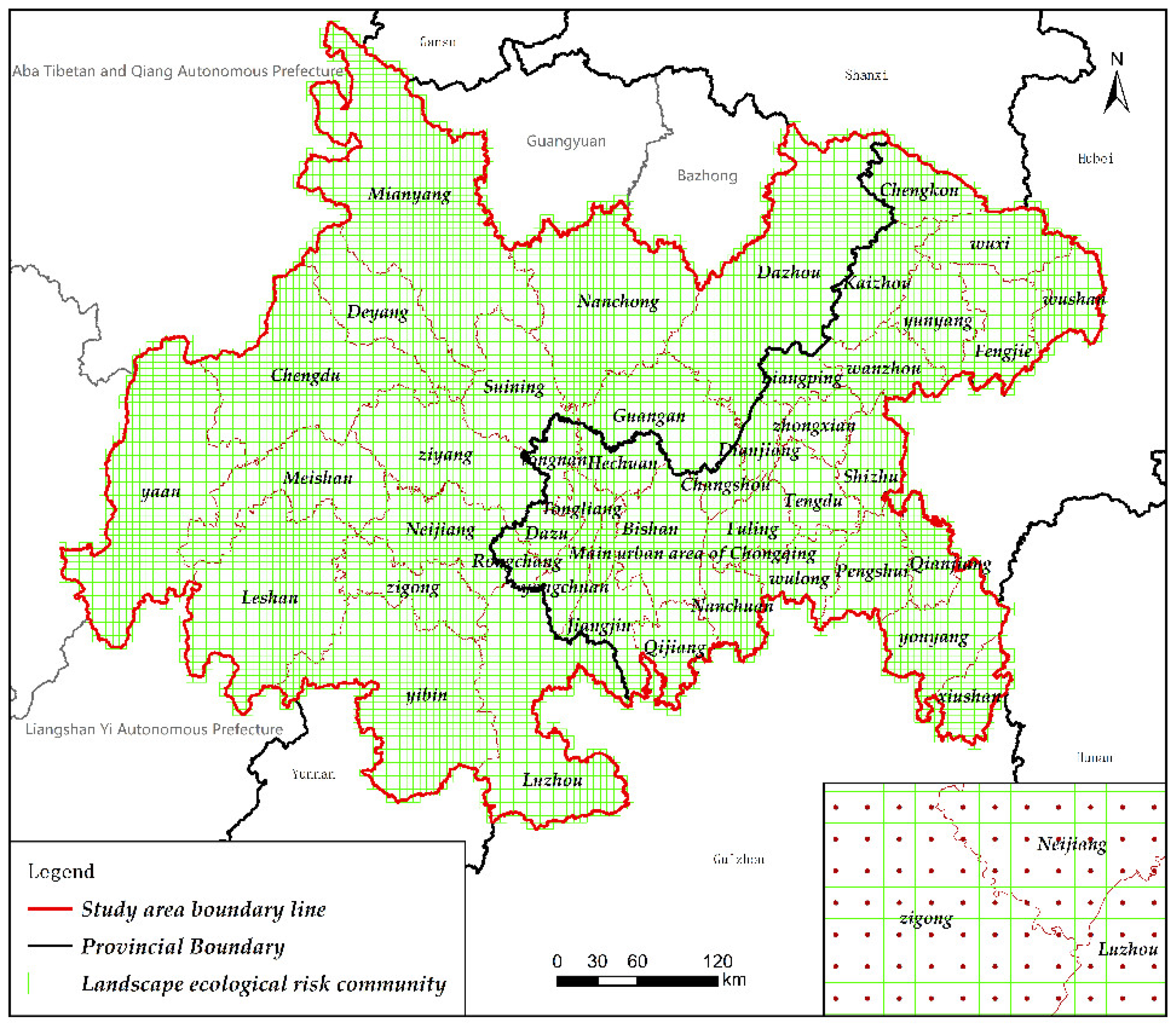
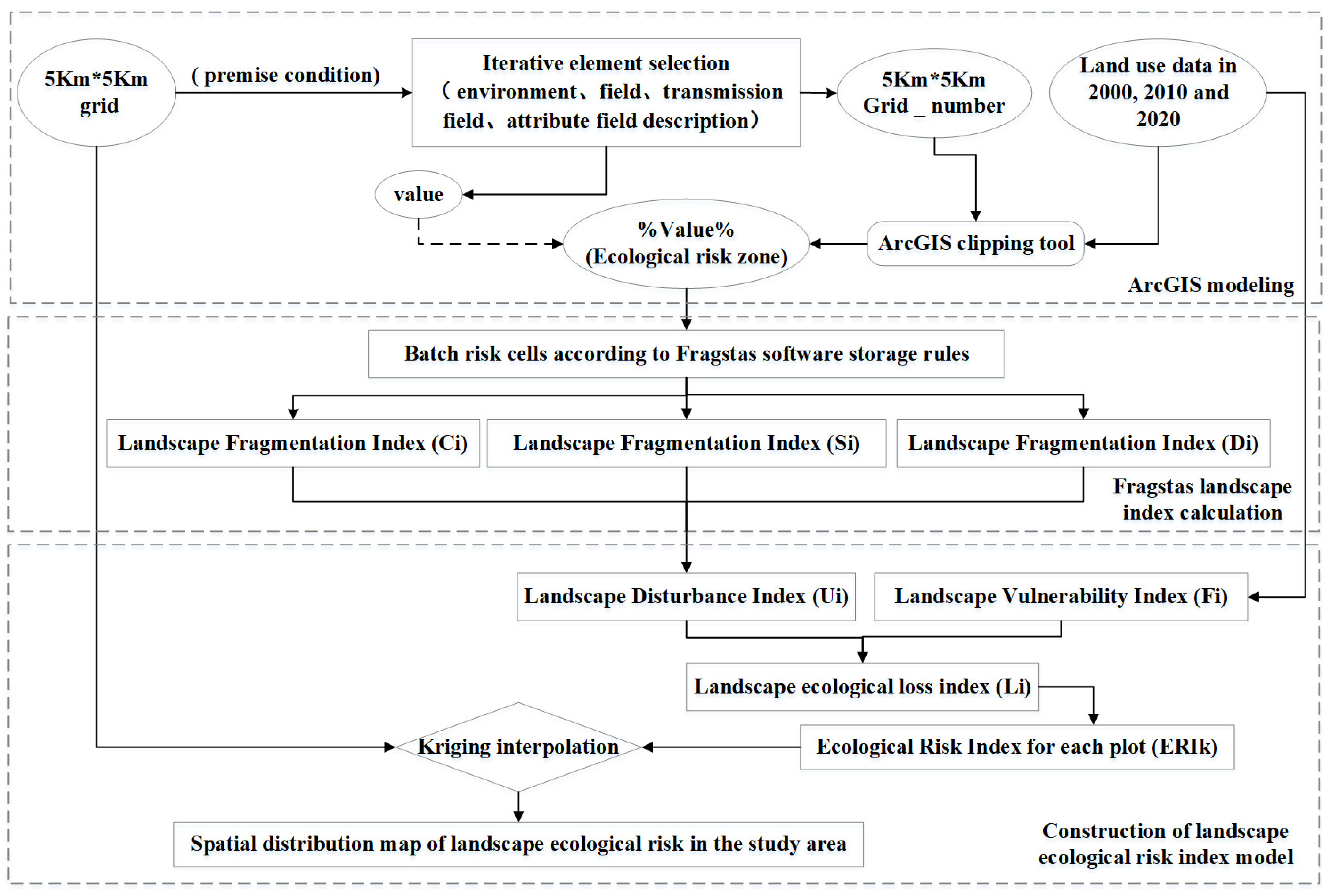

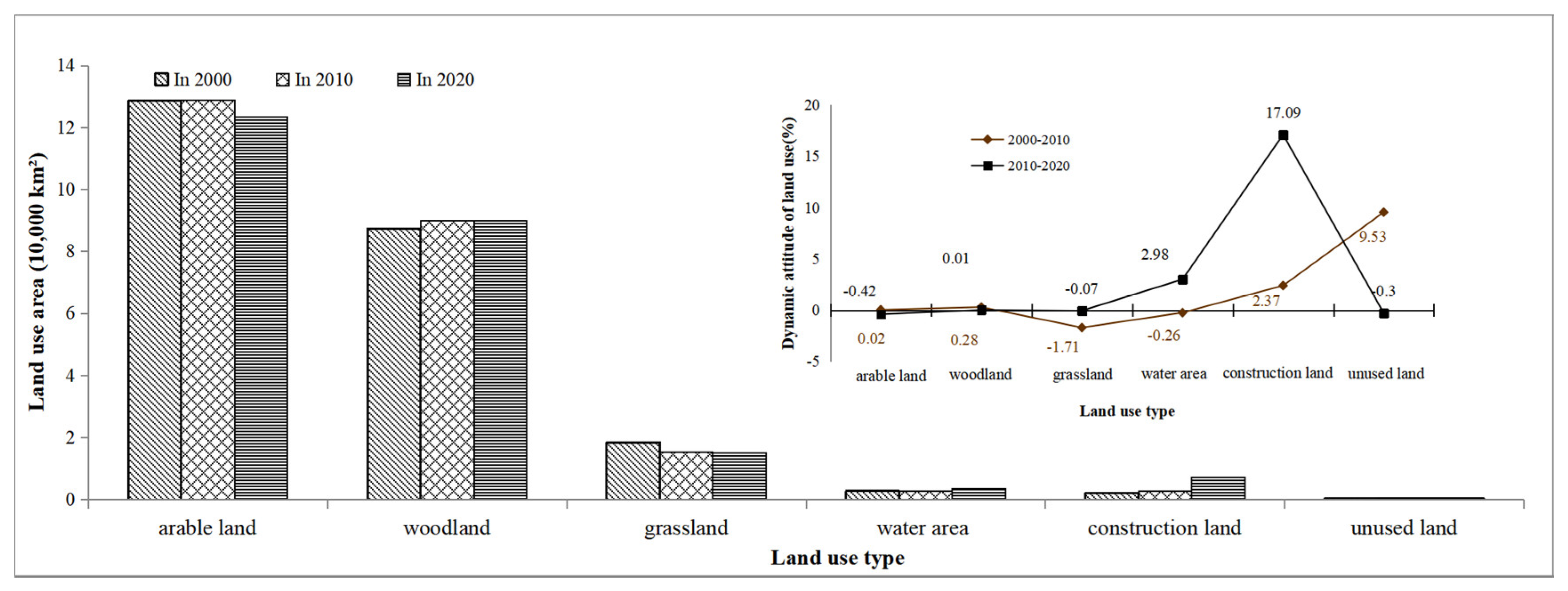
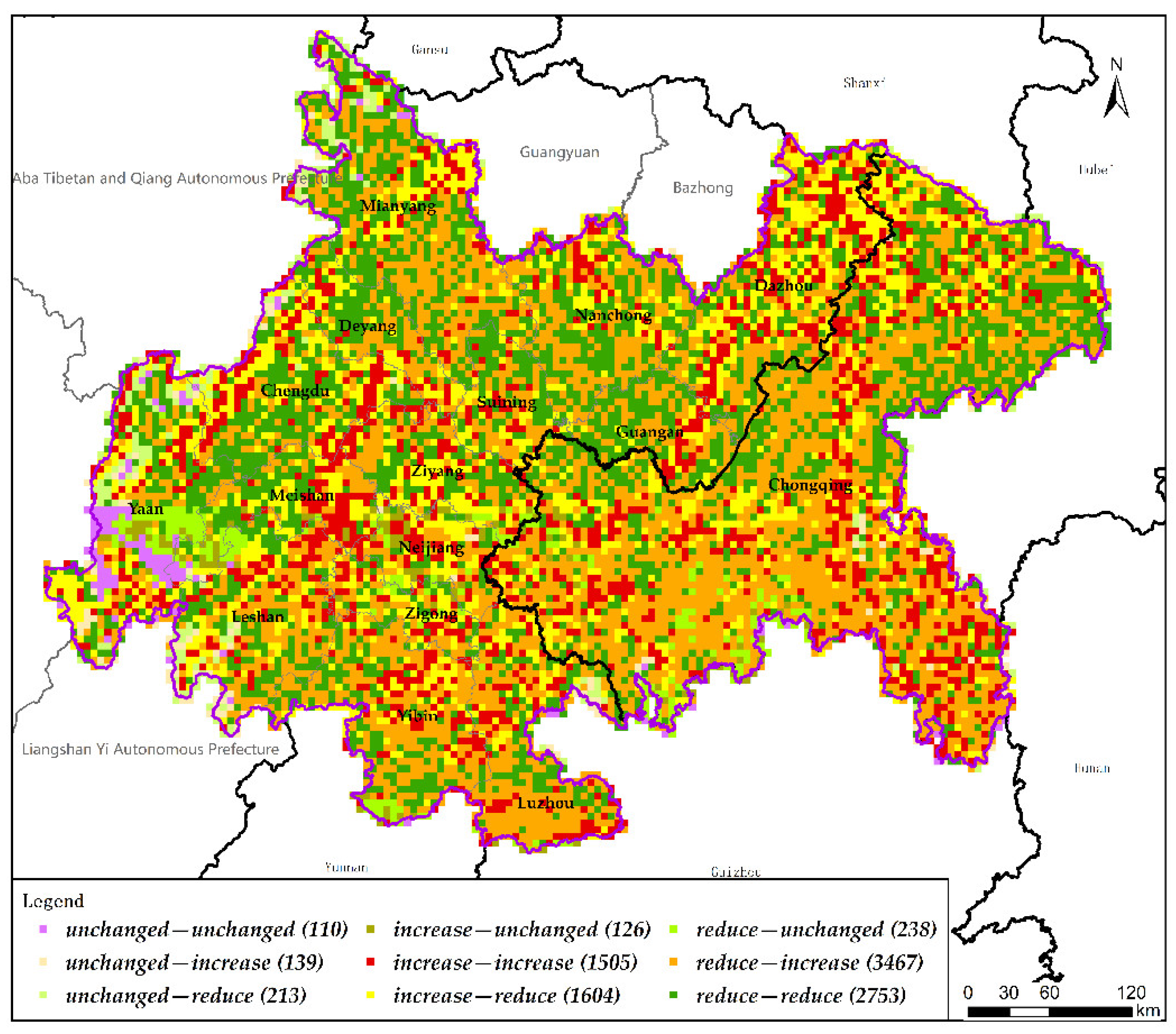

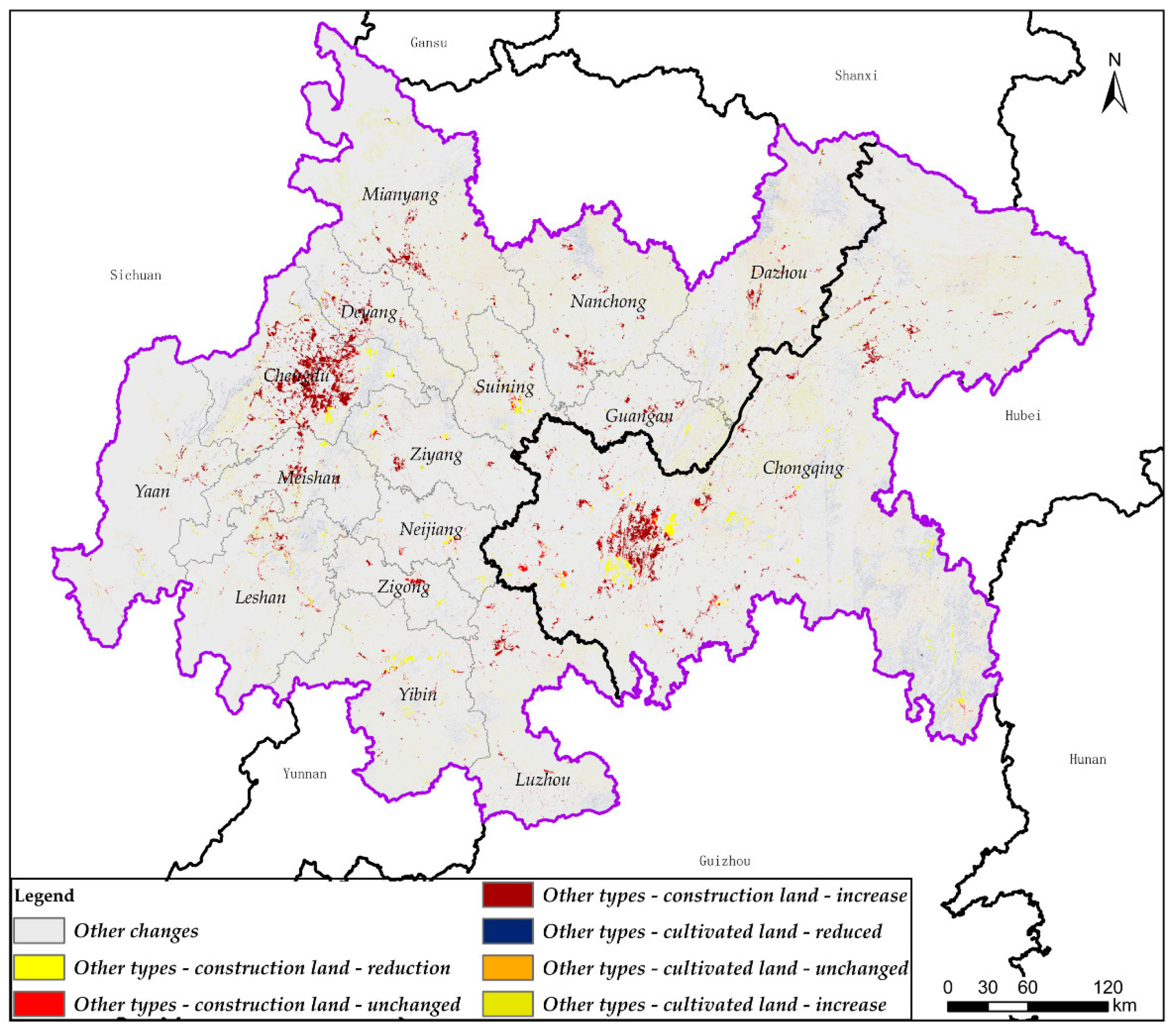


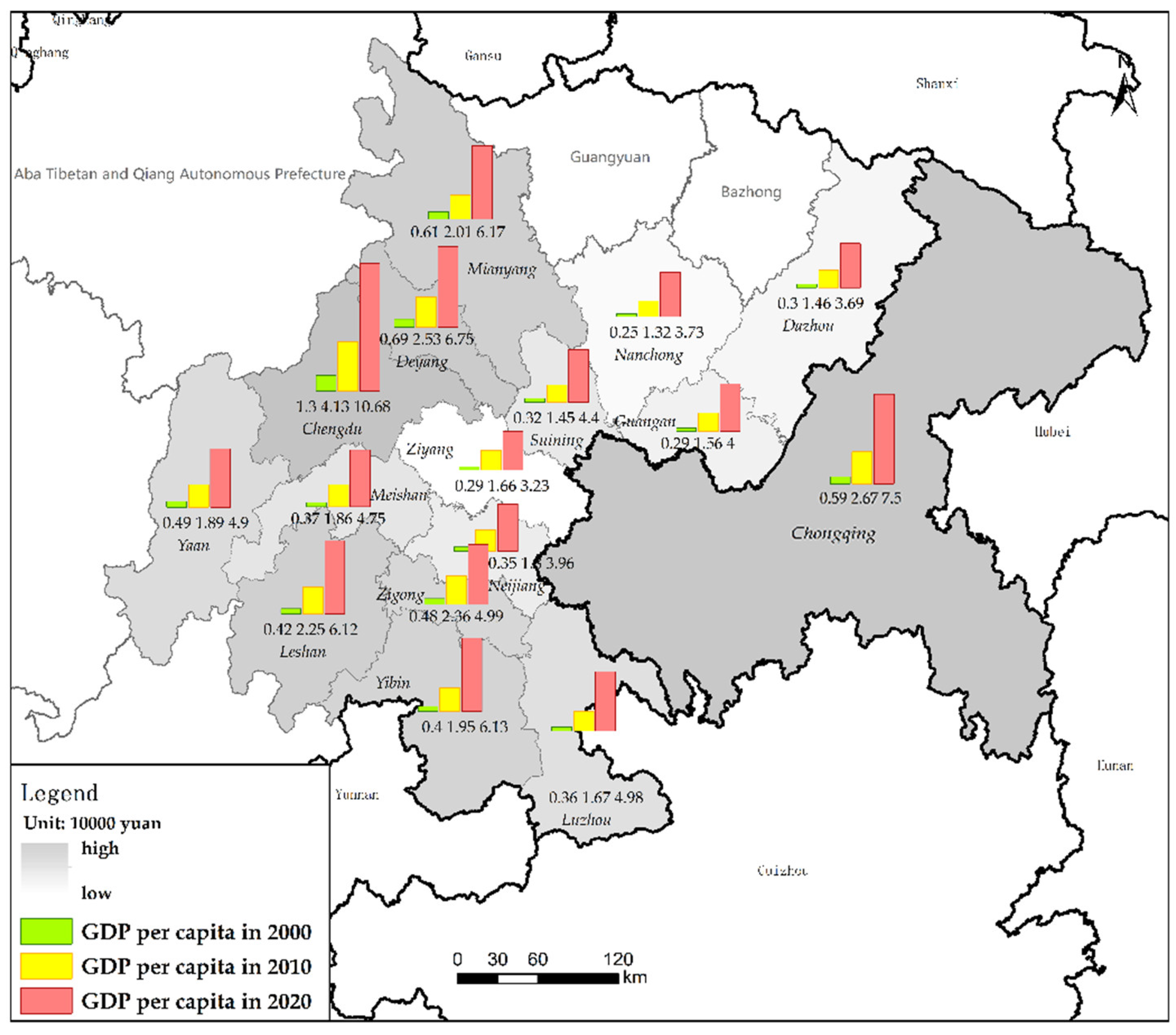
| 2020 | Cultivated Land | Forest Land | Grass Land | Water Area | Construction Land | Unused Land | Total | |
|---|---|---|---|---|---|---|---|---|
| 2020 | ||||||||
| Cultivated land | 117,959 | 3684 | 1209 | 889 | 4866 | 2 | 10,651 | |
| Forest land | 2907 | 81,126 | 2901 | 258 | 205 | 15 | 6285 | |
| Grassland | 1795 | 5004 | 10,927 | 365 | 359 | 4 | 7527 | |
| Water area | 523 | 75 | 112 | 2106 | 66 | - | 777 | |
| Construction land | 265 | - | 22 | 28 | 1868 | - | 316 | |
| Unused land | - | 1 | 6 | - | - | 9 | 7 | |
| Total | 5491 | 8764 | 4250 | 1540 | 5496 | 21 | ||
| City Name | Per-Capita GDP (Million Yuan) | City Name | Per-Capita GDP (Million Yuan) | ERIk | |
|---|---|---|---|---|---|
| Chongqing | 3.59 | 0.17 | Mianyang | 2.93 | 0.15 |
| Chengdu | 5.37 | 0.15 | Nanchong | 1.77 | 0.15 |
| Dazhou | 1.82 | 0.15 | Neijiang | 2.04 | 0.15 |
| Deyang | 3.32 | 0.15 | Suining | 2.06 | 0.14 |
| Guangan | 1.95 | 0.15 | Yaan | 2.43 | 0.14 |
| Leshan | 2.93 | 0.19 | Yibin | 2.83 | 0.19 |
| Luzhou | 2.34 | 0.19 | Ziyang | 1.73 | 0.14 |
| Meishan | 2.33 | 0.15 | Zigong | 2.61 | 0.16 |
Publisher’s Note: MDPI stays neutral with regard to jurisdictional claims in published maps and institutional affiliations. |
© 2022 by the authors. Licensee MDPI, Basel, Switzerland. This article is an open access article distributed under the terms and conditions of the Creative Commons Attribution (CC BY) license (https://creativecommons.org/licenses/by/4.0/).
Share and Cite
Zeng, C.; He, J.; He, Q.; Mao, Y.; Yu, B. Assessment of Land Use Pattern and Landscape Ecological Risk in the Chengdu-Chongqing Economic Circle, Southwestern China. Land 2022, 11, 659. https://doi.org/10.3390/land11050659
Zeng C, He J, He Q, Mao Y, Yu B. Assessment of Land Use Pattern and Landscape Ecological Risk in the Chengdu-Chongqing Economic Circle, Southwestern China. Land. 2022; 11(5):659. https://doi.org/10.3390/land11050659
Chicago/Turabian StyleZeng, Chunfen, Jun He, Qingqing He, Yuqing Mao, and Boya Yu. 2022. "Assessment of Land Use Pattern and Landscape Ecological Risk in the Chengdu-Chongqing Economic Circle, Southwestern China" Land 11, no. 5: 659. https://doi.org/10.3390/land11050659
APA StyleZeng, C., He, J., He, Q., Mao, Y., & Yu, B. (2022). Assessment of Land Use Pattern and Landscape Ecological Risk in the Chengdu-Chongqing Economic Circle, Southwestern China. Land, 11(5), 659. https://doi.org/10.3390/land11050659









